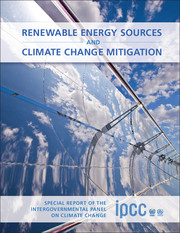 Renewable Energy Sources and Climate Change Mitigation
Renewable Energy Sources and Climate Change Mitigation Published online by Cambridge University Press: 05 December 2011
Executive Summary
To achieve higher renewable energy (RE) shares than the low levels typically found in present energy supply systems will require additional integration efforts starting now and continuing over the longer term. These include improved understanding of the RE resource characteristics and availability, investments in enabling infrastructure and research, development and demonstrations (RD&D), modifications to institutional and governance frameworks, innovative thinking, attention to social aspects, markets and planning, and capacity building in anticipation of RE growth.
In many countries, sufficient RE resources are available for system integration to meet a major share of energy demands, either by direct input to end-use sectors or indirectly through present and future energy supply systems and energy carriers, whether for large or small communities in Organisation for Economic Co-operation and Development (OECD) or non-OECD countries. At the same time, the characteristics of many RE resources that distinguish them from fossil fuels and nuclear systems include their natural unpredictability and variability over time scales ranging from seconds to years. These can constrain the ease of integration and result in additional system costs, particularly when reaching higher RE shares of electricity, heat or gaseous and liquid fuels.
Existing energy infrastructure, markets and other institutional arrangements may need adapting, but there are few, if any, technical limits to the planned system integration of RE technologies across the very broad range of present energy supply systems worldwide, though other barriers (e.g., economic barriers) may exist. Improved overall system efficiency and higher RE shares can be achieved by the increased integration of a portfolio of RE resources and technologies.
To save this book to your Kindle, first ensure [email protected] is added to your Approved Personal Document E-mail List under your Personal Document Settings on the Manage Your Content and Devices page of your Amazon account. Then enter the ‘name’ part of your Kindle email address below. Find out more about saving to your Kindle.
Note you can select to save to either the @free.kindle.com or @kindle.com variations. ‘@free.kindle.com’ emails are free but can only be saved to your device when it is connected to wi-fi. ‘@kindle.com’ emails can be delivered even when you are not connected to wi-fi, but note that service fees apply.
Find out more about the Kindle Personal Document Service.
To save content items to your account, please confirm that you agree to abide by our usage policies. If this is the first time you use this feature, you will be asked to authorise Cambridge Core to connect with your account. Find out more about saving content to Dropbox.
To save content items to your account, please confirm that you agree to abide by our usage policies. If this is the first time you use this feature, you will be asked to authorise Cambridge Core to connect with your account. Find out more about saving content to Google Drive.